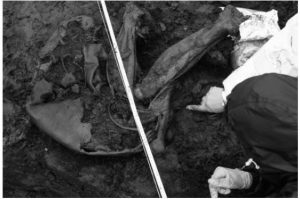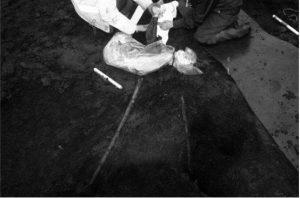

On Wednesday 10th of August 2011, a remarkable find was uncovered on a bog in Co. Laois. A bog body was unearthed during peat milling at Cashel bog between Portlaoise and Abbeyleix by Jason Phelan, a Bord Na Mona worker. After over two years of analysis, it was revealed that the body was in fact over 4000 years old dating to the Early Bronze Age Period in Ireland. The news made national and international headlines, as it was clear that the find on this Laois Bog was the oldest fleshed bog body ever found in Europe. Over 100 such bodies have been found in Ireland to date, many of these were recorded in the 19th Century when turf cutting by hand was prevalent. Nine of these have been dated to the Iron Age on the island. The waterlogged conditions of the bogs provide low oxygen/ mild acidic conditions which allow chemical reactions to preserve human flesh, giving us a rare glimpse of individuals who roamed these landscapes centuries and millennia ago. A widely excepted theory on these remains which have been found in Ireland and throughout north-western Europe is that they may have been victims of ritual killing. It has been well documented that during the Iron Age culture, local kings were often ritually married to the Goddess of the Earth. This bond was essential for fertility of the local community both in terms of crops, animals and general well-being. If problems arose the king himself may be have been held responsible and as a means of alleviating the dire situation the local community found itself in, the king may have been ritually sacrificed to appease the forces of nature. It has been shown that many of these ritual sacrifices have occurred within liminal places in the landscape. Territorial boundaries, which bogs and water courses often acted as, provided ritual killing sites where otherworldly beings were believed to reside. In the case of Cashel Man, this theory seems to fit in neatly with the evidence uncovered by archaeologists. Cashel bog lies on an ancient territorial boundary below an inauguration site at Crosy Duff hill (Cros Dubh). Over the years a number of other archaeological finds have been unearthed including; bog butter, a stone axehead, copper axeheads which all seem to suggest a place of ritual votive deposition. The analysis of the remains of the body (which would have been fully intact before the milling machine passed over) showed definite signs of injury which included a blow to the arm which caused a breakage as well as a large cut to the back. Two hazel sticks which were inserted into the bog at an angle just above where the head would have been positioned may have acted as a harness to keep the individual from moving away, perhaps during the sacrifice. It would have been a gruesome scene, but one deemed necessary by the inhabitants of the area in order to return the favour of the Gods.

The radio carbon dates taken from the individual show that he was an inhabitant of county Laois around 1900 BC. From the evidence it seems he was likely a young king between the ages of 20-25 who met a violent death perhaps to ensure the survival of his people. Until his remains were discovered, these ritual death practices were only believed to have occurred in the Iron Age period but now the practice seems to have extended further back in time to the Early Bronze Age. Cashel man was a remarkable discovery and shows that an organized society, albeit with some grim ritual practices had developed in the county almost 4000 years ago.
Further Reading: Eamonn P. Kelly. The Bog Body from Cashel Bog, Co. Laois 31/01/13.
Comments
Post a Comment